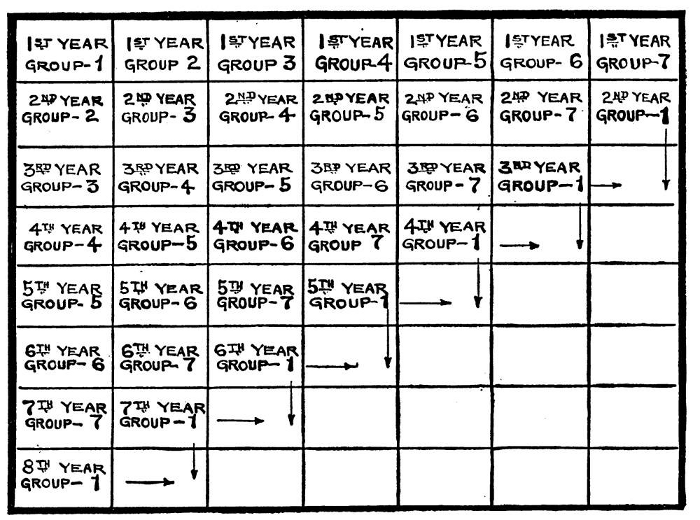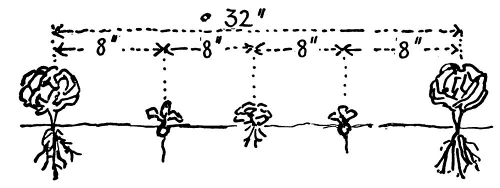The following information on crops and cropping systems comes from Five Acres and Independence by M. G. Kains. Five Acres and Independence is also available to purchase in print.
No man can do his best when sick; neither can a soil! Under such conditions the character and quantity of both human and soil products are below par and continue to slump as long as unfavorable conditions last. In countless cases diagnosis shows that one or more fundamental principles of health have been or are being violated; for experience proves that when these are followed health and production are normal and characteristic.
The commonest way by which soils become “sick” is by being forced to produce the same crop or closely (botanically) related crops year after year without change. Like yourself, soils not only enjoy variety of diet but evidence their appreciation by increased and more profitable production. Hence has arisen “crop rotation,” a general farming practice which consists in having from 2 to 5 unrelated crops occupy the land in prescribed sequence, usually during as many, often more years.
The advantages of rotation are: 1, Each crop of a well planned rotation leaves the soil in good physical condition for the next; 2, faults and disadvantages of one season’s treatment may be corrected in the next; 3, plant foods may be maintained in better balance and supply than when the same or related crops are grown continuously; 4, plant diseases and insect enemies that live in the soil are starved out; 5, trouble from weeds is reduced; 6, labor is economized for various of the above reasons; 7, one or more of the crops (a green manure) maintains or helps to maintain the supply of humus in the soil and when this crop is a legume (e.g., clover); 8, the supply of nitrogen in the soil is supplemented or maintained at trifling cost. Rotation of crops implies and includes rotation of tillage, manuring and other cultural practices so the land benefits both directly and indirectly.
Actually, of course, soils do not become “sick.” Unlike a human or an animal, they do not need to recuperate. The trouble with them is usually either that they leave an excess of certain by-products in the soil, due to a repetition of one crop (or of botanically related crops), or they have exhausted the available supplies of certain elements necessary to their welfare.
When such conditions occur in market gardening, as they often do, they are most easily and economically corrected by seeding down the area to grass for at least two years. By this practice a crop of hay (and aftermath) may be harvested, a sod may be plowed under to add humus to the soil and the physical texture of the soil improved.
Instead of resorting to this remedy it is better to divide the cropping area (when large enough to be worth while) into at least five equal parts each of which shall take its turn to produce a hay crop. Each of the other divisions should be devoted consecutively to produce a root crop (turnips, beets), a fruit crop (tomatoes, cucumbers), a salad crop (lettuce, cabbage) and a seed crop (corn, peas). Where this practice is not feasible the seven-year plan illustrated in Figure 34 will provide a good substitute.

In addition to crop rotation, four other systems of cropping are practised to gain other ends. 1. Marker cropping consists in thinly sowing seed of a quick-sprouting and maturing crop in the same rows as a slow sprouting one (parsnip, carrot) or one whose seedlings are hard to see (beet, onion) when they first come up. The favorite marker is a forcing variety of radish. In less than a week (often in three or four days) the broad seed leaves of the radish appear and thus mark the location of the rows thus acting as guides for the hoe which should be started that early.
When the radish seeds are dropped about 2″ apart the seedlings do not interfere with the permanent crop and when a quick maturing variety is sown the radishes should all have been gathered within a month, thus leaving the later crop in full possession. The practice is applicable on only a small scale because the seed of each crop must be sown separately by hand. When seed is sown by a drill marker cropping is not necessary because the roller of the drill presses down the soil above the rows and leaves an easily seen mark which serves as a guide for the wheelhoe that should be used a day or two after sowing.
2. Partnership cropping consists of growing two or more different crops from start to finish on the same area. Favorite crops so treated are pumpkins or winter squash with corn; pole beans with corn; dwarf peas, tomatoes or bush beans with strawberries. In this last case the vegetable plants are removed as soon as they have been cropped. The ground is then cultivated.
In one of my gardens I set strawberry plants 24″ apart each way, planted corn between them in one direction, sowed pole beans to climb on the corn, bush beans between the rows and winter squash at 8″ intervals. All did well except the squash which made a poor stand because of the heavy clay soil. The strawberries yielded abundantly the year following.
3. Companion cropping consists in sowing alternate rows or setting alternate plants of two or more crops that require different lengths of time to mature. The short season crops are removed before the long season kinds need the whole space, thus neither interferes with the other so several crops may be harvested from the same area. To be successful it is essential that the companions mature at different seasons, that one be a catch crop or less valuable than the other, that each requires the same tillage and plant food and that all are preferably of different botanical families so as to avoid insect and disease troubles and soil robbery of important plant food materials.

Favorite companion crop combinations are: radishes between rows of beets, carrots or turnips; onion sets alternating with rows of onions sown as seed; onion sets and early cabbage or kohlrabi; parsnips and early carrots; leeks and early beets; bush beans and tomatoes or eggplants or peppers; cucumber or melon with bush beans; lettuce plants set between early cabbage plants or cabbage rows or both or also with radishes in continuous rows between the rows of cabbage and lettuce. In this last case the radishes are removed before the lettuce needs the space, then the lettuce is gathered and the cabbage left in full possession. This may then be followed by a succession crop.
4. Succession cropping consists in sowing or planting a second, a third or even a fourth crop in sequence on the same area during the same season. To operate it the maturing period of each crop must be short enough to allow its successor ample time to mature and, for reasons already given, preferably each crop should be of a different botanical family from its two or three predecessors.
Favorite succession crops are: Earliest sown or planted—round beet, peas, forcing carrot, lettuce, radish, early cabbage, peppergrass, mustard, spinach, kohlrabi, turnip, scallion, early potato, fetticus. Second sown or planted—bean, beet, corn, cucumber, melon, citron, eggplant, New Zealand spinach, okra, pepper, pumpkin, celery, cauliflower, kohlrabi, squash, tomato, rutabaga, turnip, late cabbage, Brussels sprouts, kale. Third sowing or planting (for fall use)—round beet, forcing carrot, winter radish, spinach, fetticus, cress, radish, turnip, mustard.
Crops not suited to succession cropping because they occupy the ground from spring to fall: parsley, parsnip, sweet potato, chicory, salsify, leek, scorzonera and the perennial vegetables—asparagus, artichoke and rhubarb.
